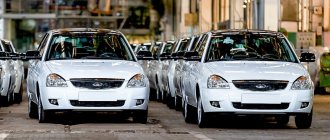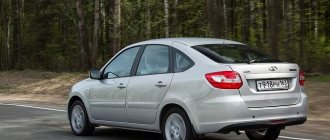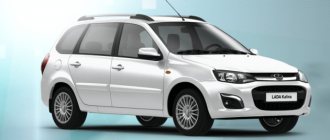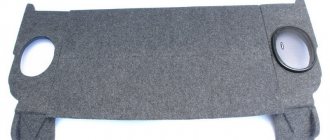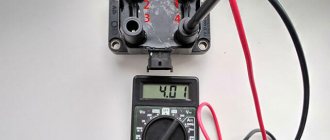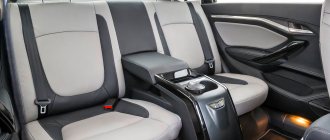When planning to purchase a new car, consumers usually look at descriptions of various models to choose the option that best suits their needs. The trouble is that the average person cannot always understand the specific terminology of the automotive industry.
Even the classification of cars by body type is not clear to everyone, since many still have only the vaguest idea of the differences between a sedan, hatchback and station wagon. Well, let's try to clarify this issue.
Liftback
A liftback is a type of closed car body that is intermediate between a sedan, station wagon and hatchback. It differs from the hatchback in the longer rear overhang: the liftback has the same length as the sedan. The rear part of the roof can be either sloping or (less often) stepped, reminiscent of a sedan.
Body type Liftback
Station wagon
A station wagon is a compromise between a car and a truck. These are cars created on the basis of hatchbacks with an elongated body and a large amount of luggage space. Passenger seats in station wagons fold and stow away, significantly increasing vehicle space and cargo capacity. A station wagon can have 3 or 5 doors.
Volkswagen Passat Passat
Minibus
Designed for transporting people, capacity 8-16 seats. Closed body type. The height of the minibus allows passengers to be transported only in a sitting position.
The bus body is at least 5 and a half meters long. Designed to transport passengers and luggage. In terms of the number of passengers, capacity starts from 7 seats.
Expresses the design feature of a passenger car body. It consists in refusing to use central supporting elements and non-retractable glass frames in the design. Translated from English. Like a hard roof.
A sedan or hatchback with an unusually high top. Typically, such cars are used exclusively for taxi needs.
In some European countries, a body with a door on the rear of any model is classified as a combi. Presented the combi type in the Soviet Union IZH -2125.
Literally can be translated as a fast trunk. The name justifies the appearance of this type. After all, the fastback roof seamlessly goes directly into the trunk
The body is a passenger car type, without roll-up windows, but with a folding soft roof. An example of such a car is the ceremonial ZIL convertible.
An outstanding feature of the landau type body is the detachable or foldable roof over the passenger area.
Another name for this body type is coupe de ville. It has an open part of the roof over the front of the passengers along with the driver.
Sports type without roof. A relative of the roadster, but the height of the windshield does not exceed the level of the driver's eyes or forehead. Sometimes it is even lower. The wind in your face is about the spider.
Two-volume
The two-volume body does not have a protruding trunk, and its lid opens only with the glass and is considered another door.
Two-volume bodies include hatchbacks, station wagons, as well as crossovers and SUVs created on their basis. Two-volume bodies are distinguished by the most spacious luggage compartments (station wagons) and compact dimensions (hatchbacks - “hatchback”, can be translated in English as “rear door”). At the same time, both station wagons and hatchbacks have a folding rear seat, which allows you to significantly increase the volume of the trunk and the characteristics always indicate its minimum (i.e., with the seats folded down) and maximum (with the seats folded down) values.
Hatchback, station wagon.
Crossover or sedan. pros and cons.
When compact crossovers began to catch up and overtake sedans in sales volume in the new car market, heated debate broke out about the validity of this situation. Despite the fact that this situation has been going on for several years, a final answer to the question “crossover or sedan” has not yet been found. I’ll try to formulate five reasons in favor of a crossover and five in favor of a sedan, such as the Hyundai Solaris.
Crossover. More cargo space. Crossovers, like hatchbacks, are more spacious than sedans. Not only that, sometimes even with the rear seats folded down, the trunk volumes of crossovers and sedans are almost the same, but if you fold the back row, crossovers have simply a huge space for transporting anything you want. If you regularly have to transport not only people, but also a lot of things and cargo, this is an obvious plus in favor of a crossover.
Crossover. All-wheel drive is permanent or plug-in. Do you live in a region where it is not summer all year round? Snow, mud, and even roads of not the best quality? Do you like to travel and go out into nature? Well then, all-wheel drive is what you need. Although, of course, there are sedans with all-wheel drive, but for crossovers it is actually a basic requirement. In fact, if you need better cross-country ability, then you can safely look at all the crossovers on the market, and not look for a few all-wheel drive sedans, which, moreover, often cost quite an outrageous amount of money.
Crossover. Boarding of the driver and passengers. One of the reasons for the popularity of crossovers was the high seating position of the driver and passengers. A seating format that allows the driver to sit higher than in a sedan, along with reasonable fuel economy, makes crossovers more popular than old-school cast-iron SUVs. In urban environments, better visibility allows you to better see and assess your surroundings.
Crossover. Off-road. Do you often cross mountain rivers, tractor tracks and small fords? Then a full-fledged SUV is your choice. And in order to get into the forest, through muddy spring mud or a rocky area, a crossover will be more than enough. Sedans really have nothing to do here. Well, if only WRX...
Crossover. More and more great options. With the growing popularity of the crossover class, manufacturers began to offer ever richer and more interesting configurations, expanding their engine ranges and the amount of additional equipment. Which, in principle, begins to equalize them in terms of comfort and equipment with sedans.
———————————————————————————————
Sedan. Fuel economy. Although the crossover has come a long way from large SUVs that guzzle buckets of gas, and today can boast of quite interesting efficiency indicators, sedans are still more economical one way or another. On average, a sedan consumes 10-15% less fuel than a crossover.
Also interesting: Vehicle driveshaft device
Sedan. Boarding of the driver and passengers. Life is such that not everything can be measured by averages. And people are often taller than average. Which imposes certain restrictions on cars. If in most C and D class sedans a person with a height of 180 to 200 centimeters will feel quite comfortable, thanks to the reclining seating position, then in most crossovers he will need to open the hatch so as not to rest his head on the roof.
Sedan. Proven design. Proven does not mean old at all. When buying a Toyota Camry or VW Passat, we know what we are getting. For many years. But what is that same RAV4? Big Prius? Or something else? That is, most crossovers are assembled on a sedan platform. And here the question is - which is better?
Sedan. Visibility. Parking sensors almost in a circle, all-round cameras, blind spot monitoring systems and much more that have recently begun to be shoved into crossovers without limit, this is an attempt by manufacturers to compensate for not very good visibility and a sense of size (for example, the same Mercedes Benz GLA with visibility point of view is not very good). For a sedan, a rear view camera and parking sensors front and rear are often sufficient.
Sedan. Elegance and style. Mercedes-BenzCLA-class, FordFusion, KiaOptima, JaguarXF, Dodge Charger, BMW6-series GranCoupe... Continue? In principle, if you really value style in a car, a sedan has much more advantages.
- Hyundai Tucson N Line For quite a long time, sports versions of production cars were the prerogative of exclusively German ones, and well...
- The Audi e-tron is the brand's first production electric car, the world premiere of which took place in San Francisco. Full size…
- While the “cool wheels”, or rather, the photo shoot, are being stored on a flash drive until maturation in the first days of the coming week, I would like to say...
- To look at the latest Russian and foreign mass tuning, all you have to do is come to Vorobyovy Gory and everything will immediately become clear. Trends,…
- This year marks the 50th anniversary of the annual SEMA Show in Las Vegas. This has already become a traditional automobile...
- The automotive world is structured in such a way that, despite sales plans and market trends, exceptions to the rules appear from time to time, which, no matter…
- Even in its previous generation, the Ford F-150 Raptor gained considerable popularity with its aggressive appearance, powerful engine, and all that...
- When the famous Swedish car manufacturer Volvo, which at that time was not in the best shape after a break with Ford,...
- The massive gates rise in front of you and the SEMA Garage appears before your eyes. The place where powerful and famous cars are born. And the first thing...
Coupe
Typically, a coupe (from the French “couper” - to cut) is created by companies that produce powerful sports cars. A prominent representative of this type of body is the Porsche 911. As a rule, a coupe car is designed for two passengers, has two doors and a structurally separated trunk. The roof of the coupe at the rear has a sloping shape, and the body itself is “pressed” to the ground, which allows you to achieve a sporty style.
A separate type of coupe is the convertible.
- instead of a hard roof, the convertible has a “soft” folding roof-awning that rises and folds as needed.
A convertible designed exclusively for two people - a driver and a passenger - is called a roadster.
Conservatives
The three-volume body has a protruding hood and trunk. Three-volume vehicles are among the least versatile bodies due to the limited possibility of transforming the interior and trunk. This group includes sedans, coupes, convertibles and pickups.
Sedan, coupe
The most striking representative of the three-volume body is the sedan, which is present in the model range of almost all manufacturers. The sedan is considered the most conservative (classic) and prestigious body type. The sedan is extremely popular on our roads, where “prestige is everything,” and cars are divided into sedans and non-sedans.
A convertible is a coupe with a “soft” tent roof that folds behind the rear seats and rises if necessary.
But the soft top did not allow the car to be used all year round, so in the late 90s a new version of the open body began to gain popularity - the coupe-convertible. At first glance, it looks like a regular coupe, but when you press the right button, the hard metal roof lifts up and neatly folds into the trunk, turning the coupe into a convertible.
A two-seater convertible (without a second row of seats) is called a roadster (for example).
Pickup
A pickup truck is a body with an open cargo area separated from the interior by a rigid partition. Simply put, it is a smaller copy of a regular truck. Most pickup trucks are built on the same platform as SUVs and have good cross-country ability. Both here and throughout Europe, pickup trucks are not particularly popular, but in the USA they are crazy about them.
HATCHBACK / HATCHBACK
Also a very popular option, especially in Europe. They love hatchbacks for their affordable price, maneuverability and compact dimensions.
The main difference from the sedan is that the hatchback does not have a separately protruding trunk. The roof of the car slopes smoothly and opens into a large rear door. The role of the trunk is performed by a compartment separated from the rear row of seats by a shelf.
Inside the cabin there are 2 rows of seats, and the rear row seats and the shelf behind them usually fold down. Hatchbacks have 3 or 5 (counted together with the rear) doors.
The main differences between a hatchback and a station wagon
Common features inherent in the hatchback and station wagon - both classes are a modified sedan with an essentially combined interior and trunk.
The differences between a hatchback and a station wagon are as follows:
- The size of the luggage compartment is significantly smaller in the Hatchback. The station wagon is excellent for cargo transportation and is often purchased by private entrepreneurs and medium-sized companies precisely for these purposes;
- The hatchback features a more elegant rear design. The inclined door looks much more beautiful than the strict vertical overhang of the station wagon. Women often make choices based on this;
- The station wagon is longer than the hatchback. This can be a significant drawback in urban environments if the car is used only for transporting passengers, but when it comes to large cargo, this is definitely an advantage;
- The hatchback can be supplied in a “sporty” 3-door configuration;
- Station wagons, as a rule, are more expensive than hatchbacks of the same series.
Both classes of passenger cars discussed in this article occupy their niche in the domestic market and are in demand among Russian motorists due to their features.
Sedan, hatchback, coupe and others... We learn materiel
The body is a kind of metal glazed shell that houses the three main components of a passenger car: the power unit (engine), passengers and luggage. They can be arranged in different ways, and the shapes of the bodies differ from each other.
The most common are: sedan, station wagon, hatchback, coupe and, increasingly popular in Russia, minivan. Perhaps everyone knows what a limousine and a convertible, a van and a pickup truck look like. But only the most ardent car enthusiasts can imagine what a landau, brogue, roadster or fastback is.
Sedan
A three-volume body with two or three rows of seats, two or four doors and a trunk structurally separated from the passenger compartment. This body model is typical for most passenger cars. The volume of the trunk and interior differs. Convenient for transporting passengers, but practically not intended for transporting cargo.
The rear window on a sedan is always rigidly fixed in the frame and does not rise, although the back of the rear seat can either be equipped with a hatch or recline to transport long items. In North America, such a body is often called a notchback. A sedan without B-pillars, and sometimes with door glass without outer frames, is called a hardtop sedan. A sedan with two doors is called a Tudor. This body type is the most common among passenger car bodies.
Station wagon
A two-volume body with three or five doors with one or two rows of seats, having a permanent cargo space not separated from the passenger compartment by a stationary partition (the rear row of seats is folding). Passengers in the third row of seats can also sit either with their backs to the direction of travel, or in separate seats along the sides of the body.
Hatchback
A two-volume cargo-passenger body with two or four side doors and one cargo door in the rear of the body (the total number of doors is three or five). Two rows of seats. The second row and the shelf behind it can be folded or removed altogether, dramatically increasing the useful volume of the cargo space. The trunk is typically smaller than sedans, but folding rear seats and a roof-to-bumper tailgate allow the hatchback to load and carry fairly bulky items.
Coupe
A closed three-volume or two-volume passenger body with two or (less often) three doors (the third is located at the rear and combined with the trunk) and two rows of seats. The second row of seats may have limited seating dimensions. Despite the fact that initially a “coupe” is a body type designed for two passengers, there are often cars with a 2 2 seating arrangement (in this case, the rear seats are intended exclusively for children) and even full-fledged four-seater designs.
Such body models are often used in sports cars. They are distinguished by high comfort for the driver and front passenger. However, having only two entry doors makes getting into the back seat difficult, if there is one at all. The trunk of these models, as a rule, is slightly larger compared to a sedan, but not significantly.
Sports coupeExecutive coupe
Minivan or UPV (high-capacity station wagons) minivan
A kind of cross between a bus and a station wagon. Single-volume cargo-passenger body with two, three or four side doors, two or three rows of seats. The rear part of the cabin, as a rule, is similar to a station wagon body, but has a greater number of transformations of seats and equipment. The minivan evolved from a van converted to carry passengers. The minivan's capacity is up to 7 people, which does not require an additional D class driver's license. The luggage compartment is small but roomy.
Compact van; microvan, or single-volume; multivan – a minivan designed to transport not only passengers, but also various cargoes.
coupe-convertible
Cabriolet
A type of open three-volume passenger body with a retractable top and roll-down side windows. Modern convertibles have vinyl or canvas tops and typically have only two doors. Less commonly, the roof is made of metal.
Phaeton - a passenger body with a soft folding awning and with removable side windows. Targa - a passenger body with a folding or removable part of the roof above the first row of seats. Variations are possible in the roof design. For example, the so-called “T-shaped” roof - with a central, longitudinal beam dividing the removable part into two halves. A hardtop convertible is a passenger body with a removable hard roof.
Roadster
Passenger body with a folding top, two side doors and one or two rows of seats. The second row of seats has cramped seating dimensions (2 1 or 2 2 layout). In some cases, these bodies can be equipped with a removable hard top. The roadster type is absolutely similar to the convertible body.
Landau
The passenger body of a passenger car with an opening part of the roof above the rear rows of seats.
Brougham
Passenger body with an opening part of the roof over the front row of seats
Fastback Two-volume passenger body with two or four side doors and a two-row seat arrangement. The roof slopes smoothly back, and in the trunk, isolated from the passenger compartment, there is a hatch opening from the lower edge of the rear window to the floor level (like most three-volume bodies).
Limousine
Closed three-volume passenger body of the highest class with four or six side doors, two or three rows of seats and a glass partition separating the passenger compartment from the driver's seat. With a three-row interior layout, the second row of seats is either folding or located with its back to the direction of travel.
Pickup
A cargo-passenger body with a closed cabin for the driver and passengers and an open side platform for cargo. The cabin can be equipped with two, three or four side doors and have one or two rows of seats in a 2 1, 2 2 or 2 3 configuration. The cargo bed has a folding tailgate, soft or hard top.
It is also possible to install passenger seats. is a modification of a passenger car or SUV (all-terrain vehicle) with a gross weight of up to 4.54 tons and a load capacity of up to 2.5 tons. If the body is equipped with a hard top, it turns into a van. Cars with this type of body can be designed to transport both passengers and cargo in a specially designated compartment.
Currently, there are conditionally two main design schools of “pickup construction”: the European-Australian one, which involves the creation of a pickup truck based on a conventional passenger model with a monocoque body, and the American-Asian one, in which the pickup truck is based on a durable frame chassis, often unified with all-wheel drive SUVs (SUVs). .
Accordingly, in the first case, the pickup cab is simply the front part of the passenger car interior, and the base of the floor of the single-sided platform is reinforced with additional elements or mounted on a semi-frame welded to the cabin side members, or in the second case, the front part of the body of an SUV (SUV) is used.
Van
A closed body with a partition separating the driver's area from the cargo area.
MODERN NAMES OF SOME BODIES
Sedan - limousine, saloon, Berlin. Hatchback - limousine, Berlin. Station wagon - combi, wagon, station wagon, break ( break).Roadster (roadster) – spider (spider).Cabriolet (cabriolet) – convertible (convertible).
History and external features
Coupes, like the phaeton and convertible, arose even before the appearance of the first cars and were classified as carriages. The word "coupe" comes from the French word "coupe". The first such bodies began to appear in the 19th century in France in the form of bodies for carriages. Then car manufacturers began to borrow the technologies, designs and terminology of carriage makers.
This body type has two doors, in rare cases three (one rear one is merged with the trunk), usually one or two rows of seats. The trunk is completely separate. Most often, coupes are used in sports cars. Also, in our time, the concept of “coupe” is often used for marketing purposes to emphasize the sporty style of the advertised car.
Coupes, like the phaeton and convertible, arose even before the appearance of the first cars and were classified as carriages. The word "coupe" comes from the French word "coupe". The first such bodies began to appear in the 19th century in France in the form of bodies for carriages. Then car manufacturers began to borrow the technologies, designs and terminology of carriage makers.
This body type has two doors, in rare cases three (one rear one is merged with the trunk), usually one or two rows of seats. The trunk is completely separate. Most often, coupes are used in sports cars. Also, in our time, the concept of “coupe” is often used for marketing purposes to emphasize the sporty style of the advertised car.
Sedan
Classic hatchback and sedan
The main difference between the sedan is the three-volume layout, in which the structure is divided into three parts - the engine compartment, the passenger compartment and the luggage compartment. These parts are separated from each other by partitions, which makes each volume of the body separate from the other. As for the number of doorways, this type of body can have either two or four doors.
As the automotive industry developed, different versions of sedans were produced, with certain features in the body design. The main types of sedan bodies are:
- classical;
- hardtop;
Video: Which is better, a sedan or a hatchback?
The difference between a classic sedan is that the overall dimensions of the engine and luggage compartments are approximately the same. Over time, in order to reduce the parameters of the car, which were usually significant for the “classics,” the length of the luggage compartment began to be reduced, while increasing its height to compensate for the useful volume. Ultimately, this led to the formation of the wedge-shaped body shape that all modern sedans now have. There are a lot of representatives of classic sedans, since this body type is the most popular. Examples in the domestic automotive industry are all “classic” VAZ models (except for the VAZ-2102 and 2104 station wagons), VAZ-21099, 2110, 2115, and all Volga models.
Among foreign cars, representatives of sedans are Toyota Corolla, Mitsubishi Lancer, BMW 5th, 7th series. In general, sedan cars are produced by almost all automakers.
Mercedes-Benz CL-class hardtop
A feature of the hardtop body was the absence of central pillars in the interior compartment. If in the classic version the front and rear doors were separated by a pillar stretching from the floor to the roof, then it was removed from the hardtop. In this case, usually the doors did not have glass frames, or they were retractable along with the glass in the door. Cars with sedan-hardtop bodies have not found particular popularity, and now they are practically not produced. Prominent representatives of cars in this body are the Chevrolet Impala and Cadillac de Ville Hardtop.
It is noteworthy that two-door versions of “hardtops” are still found, but most of them are classified as “coupes”.
The “fastback” body differed from the “classic” and “hardtop” in that the third compartment, the trunk, was very weakly expressed in the silhouette of the car. This was achieved thanks to a very smooth transition from the roof of the car to the rear. At the same time, the luggage compartment, although it was separate, was externally integrated into the cabin. The representative of the car with this body is GAZ Pobeda.
In the modern automotive industry there is another type of body – “liftback”, which is a transitional model between a sedan and a hatchback. Its main difference is hidden in the fact that externally there is a pronounced luggage compartment, but the body itself is two-volume and the luggage compartment is located inside the cabin. Among modern cars produced in a liftback body, the Skoda Superb can be noted.
Among the positive qualities of sedan cars, the following are noted:
- more presentable and respectable appearance of the car;
- the presence of a separate trunk;
- faster heating of the interior in winter due to the small volume;
- better safety for passengers in a rear impact (the trunk acts as a buffer).
But there are also disadvantages, of which the most obvious are:
- worse vehicle maneuverability due to large dimensions;
- complicated parking due to a worse feeling of the car’s dimensions;
- limited luggage compartment volume;
- less body strength due to large rear overhang.
Video: Lesson 2 - types of cars, hatchback, sedan, station wagon, body types, SUV, crossover, SUV
SUV
An SUV is a vehicle with increased cross-country ability. This is achieved due to increased ground clearance of the body. A classic SUV - a jeep - has a frame body, all-wheel drive, special geometry and a reduction gear.
Today, when they talk about the class of SUVs, SUV (Sport Utility Vehicle), they mean crossovers (SUVs). Driving performance and overall dimensions do not allow them to be classified as “real” SUVs.
Crossovers have 3 or 5 doors, 2 or 3 rows of seats. Today, there are crossovers in liftback or coupe body styles.
